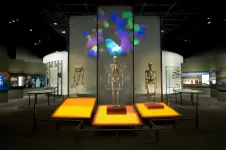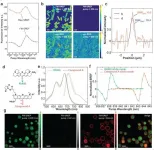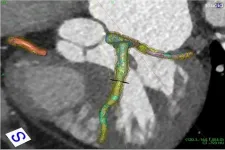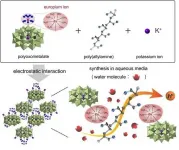(Press-News.org) Screening for a sometimes fatal condition among patients with a rare autoimmune disease could soon - thanks to a computer algorithm - become even more accurate.
Researchers at Michigan Medicine found that an internet application improved their ability to spot pulmonary arterial hypertension in patients with systemic sclerosis, or scleroderma. The unpredictable condition is marked by tightening of the skin that can damage internal organs.
The algorithm, aptly named DETECT, outperformed standard methods used to identify the form of high blood pressure in the lungs that causes the heart to weaken and fail.
"We've been advocating for a long time that every scleroderma patient should be screened on an annual basis using DETECT, and this data supports that," says Dinesh Khanna, M.B.B.S., M.Sc., senior author of the study and director of Michigan Medicine's Scleroderma Program. "Pulmonary arterial hypertension is a leading cause of death for these patients, and we want to diagnose them early."
The DETECT algorithm is a two-step algorithm that uses six different clinical variables to determine whether a patient requires an echocardiogram, or ultrasound, of the heart. The second step then informs whether the patient should be referred for a right heart catheterization.
Researchers found the algorithm correctly identified all 10 patients with pulmonary arterial hypertension in a study of 68 subjects.
"It didn't miss a single patient; it can't get better than that," Khanna says. "This is a highly sensitive screening tool and can be very useful."
Of the times DETECT identified signs of pulmonary hypertension during the study, however, only 20% of patients who had right heart catheterizations actually suffered the debilitating condition. Khanna says it's better to be cautious.
"That's the trade-off of having such a sensitive test," he says. "The right heart catheterization is invasive, but because the mortality of [pulmonary arterial hypertension] is so high, and the prevalence is so high, the benefits outweigh the risks."
Around 10% of patients with scleroderma, which affects around 70,000 people in the U.S. each year, develop pulmonary hypertension. Under current guidelines, physicians screening scleroderma patients for the condition observe an annual echocardiogram.
While it's an effective diagnostic tool for symptomatic patients, the ultrasounds don't predict the condition accurately in asymptomatic people or early in the disease, Khanna says. That inaccuracy motivated both him and principal investigator and rheumatologist Amber Young, M.D., to conduct the study.
"These ultrasounds miss around one in three patients who may have pulmonary arterial hypertension," he says. "And by the time we diagnose a patient so late, the story is over - the patient will likely die in the next two or three years," he says.
This study was the first that compared the algorithm to echocardiogram guidelines published in 2015. The research team hopes more physicians will consider using DETECT, allowing them to treat the complication earlier. And Khanna expects more studies will conclude with similar recommendations.
"I'm sure people around the globe will be doing this work and validating it," Khanna says. "Early diagnosis and treatment of pulmonary arterial hypertension will lead to better outcomes, including improved quality of life and survival in people with scleroderma."
INFORMATION:
Paper cited: "Performance of the DETECT Algorithm for Pulmonary Hypertension Screening in a Systemic Sclerosis Cohort," Arthritis & Rheumatology. DOI: 10.1002/art.41732
Disclosure: Dr. Khanna has grant support from the NIH (National Institute of Arthritis and Musculoskeletal and Skin Diseases grants K24-AR-063120 and R01-AR-07047).
Conflict of Interest: Dr. McLaughlin reports grants and personal fees from Acceleron, Actelion, fees from Altavant, Liquida, Caremark, CiViBiopharma and Gossamer Bio. McLaughlin also reports grants from Gilead, SonoVie and Reata. Dr. Khanna reports personal Acceleron, Actelion, Amgen, Bayer, Blade Therapeutics, Boehringer Ingelheim, CSL Behring, Corbus, Galapagos, Genentech/Roche, Horizon, Merck, Mitsubishi Tanabe Pharma, Sanofi-Aventis, and United Therapeutics, Dr. Khanna is Chief Medical Officer of Eicos Sciences, Inc., a subsidiary of CiviBioPharma and has stock options."
BETHESDA, Md. -- The COVID-19 pandemic heavily influenced spending on prescription drugs in the U.S. in 2020, according to the ASHP's (American Society of Health-System Pharmacists) National Trends in Prescription Drug Expenditures and Projections for 2021. Shifts in care related to the pandemic will continue to be a significant driver of drug expenditures in 2021, along with uptake in the use of biosimilars, a large pipeline of new cancer drugs, and increased approvals of specialty medications.
Prescription drug spending in 2020 grew at a moderate rate of 4.9% to $535.3 billion. Increased utilization drove the ...
Published in the Advanced Functional Materials, University of Minnesota researcher Hongbo Pang led a cross-institutional study on improving the efficacy of nucleotide-based drugs against prostate cancer and bone metastasis.
In this study, Pang and his research team looked at whether liposomes, when integrated with the iRGD peptide, will help concentrate antisense oligonucleotides (ASOs) into primary prostate tumors and its bone metastases. Liposomes are used as a drug carrier system, and ASOs are a type of nucleotide drug.
More importantly, they investigated whether this system ...
DUARTE, Calif. -- Scientists at City of Hope, a world-renowned independent research and treatment center for cancer and diabetes, have developed a novel, noninvasive liquid biopsy test for detecting lymph node metastasis in individuals with high-risk T1 colorectal carcinoma. Research on the development of the blood test was reported in a END ...
A new study is the first-ever to identify the genes for creativity in Homo sapiens that distinguish modern humans from chimpanzees and Neanderthals. The research identified 267 genes that are found only in modern humans and likely play an important role in the evolution of the behavioral characteristics that set apart Homo sapiens, including creativity, self-awareness, cooperativeness, and healthy longevity. The study, led by an international and interdisciplinary team of researchers from the American Museum of Natural History and Washington University among other institutions, is published today in the journal Molecular Psychiatry.
"One of the most fundamental questions about ...
It has been a long pursuit to develop super-resolution imaging techniques for Raman microscopy, which has intrinsic advantages of chemical specificity over the fluorescence counterpart. Despite the perceived importance and extensive research efforts, true super-resolution (defined as diffraction-unlimited) Raman imaging of biological systems in the optical far-field remains challenging due to the deficiency in sensitivity for conventional Raman scattering. Consequently, those reported super-resolution vibrational imaging methods have to base on excitation saturating, ...
The Endangered dryas monkey (Cercopithecus dryas), endemic to the Democratic Republic of the Congo, is one of Africa's most mysterious primates. The discovery of the dryas monkey killed by a hunter in the buffer zone of Lomami National Park in 2014 has prompted field research of this small species (5-7 pounds). However, they are difficult to detect because they live in dense vegetation in secondary forest thickets.
Using non-invasive research and no-flash camera traps from 2014 to 2019, scientists from Florida Atlantic University in collaboration with researchers from the FZS-Lomami Project, Democratic Republic of the Congo, now have picture-perfect details on this elusive species. They have confirmed ...
Astronomers have discovered a pulsar--a dense and rapidly spinning neutron star sending radio waves into the cosmos--using a low-frequency radio telescope in outback Australia.
The pulsar was detected with the Murchison Widefield Array (MWA) telescope, in Western Australia's remote Mid West region.
It's the first time scientists have discovered a pulsar with the MWA but they believe it will be the first of many.
The finding is a sign of things to come from the multi-billion-dollar Square Kilometre Array (SKA) telescope. The MWA is a precursor telescope for the SKA.
Nick Swainston, a PhD student at the Curtin University node of the International Centre for Radio Astronomy Research (ICRAR), made the discovery while processing data collected as part ...
Coronary artery disease (CAD) is the most common form of heart disease and is present in about END ...
Protons are the next big thing when it comes to fuel cell technology. The subatomic exchange produces power on a scale that challenges contemporary solid-state fuel cell technology, used to help power space shuttles. To realize the proton-based technology sooner, an international team of researchers have developed a hybrid material that effectively transports protons at high temperatures and humidity -- two major challenges in past attempts.
The results were published on April 19 in ACS Applied Materials & Interfaces, a journal of the American Chemical Society.
The team, led by ...
A new Portland State study challenges the idea that youth with cognitive disabilities are unable or lack potential to pursue a career in science, technology, engineering and mathematics.
In a study using national data on more than 15,000 adolescents, the researchers found that undergraduates with medicated ADHD or autism appear to be more likely to major in STEM than youth without cognitive disabilities, and youth with autism have the most positive STEM attitudes.
Dara Shifrer, the lead author and an associate professor of sociology at PSU, says that increasing access to STEM fields for youth with disabilities depends not only on encouraging them to pursue STEM majors but also to enroll in college because STEM occupations often require bachelor's degrees at ...






